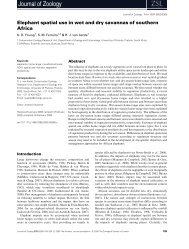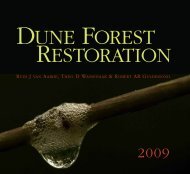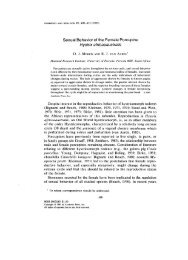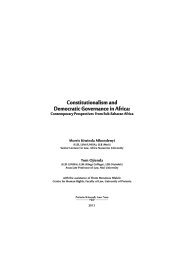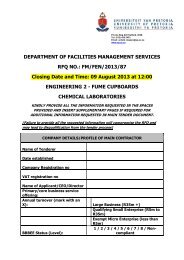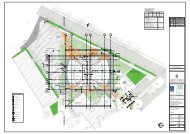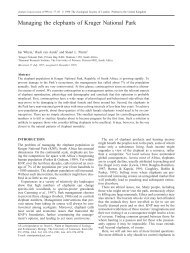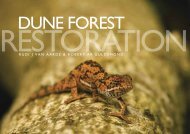Evaluation and Rating Facts & Figures - 2007 - National Research ...
Evaluation and Rating Facts & Figures - 2007 - National Research ...
Evaluation and Rating Facts & Figures - 2007 - National Research ...
You also want an ePaper? Increase the reach of your titles
YUMPU automatically turns print PDFs into web optimized ePapers that Google loves.
| 2 2 |<br />
STRIVING FOR A FAIR AND CREDIBLE PROCESS<br />
THE CREDIBILITY AND FAIRNESS of the evaluation<br />
<strong>and</strong> rating system rest, on the one h<strong>and</strong>, on the collective effort<br />
<strong>and</strong> wisdom of the Specialist Committees in identifying appropriate<br />
reviewers. On the other h<strong>and</strong>, the availability of a sufficient number<br />
of quality reports on which to base the rating decision is critically<br />
important. An Assessor moderates the process <strong>and</strong> also studies the<br />
applicant’s documentation <strong>and</strong> reviewers’ reports to reach an<br />
independent opinion on an appropriate rating category for each<br />
applicant.<br />
Assessors play a critical role in ensuring that the same st<strong>and</strong>ards <strong>and</strong><br />
criteria are applied consistently throughout the process. They also<br />
consider evidence for appeals <strong>and</strong> make recommendations to the<br />
Executive <strong>Evaluation</strong> Committee.<br />
Checks <strong>and</strong> balances in the evaluation <strong>and</strong> rating system:<br />
1. Information on the process is available on the NRF website<br />
<strong>and</strong> the criteria are clearly stipulated.<br />
2. At least six reviewers (on average more than ten) are<br />
approached for each applicant.<br />
3. Should Specialist Committees or Assessment Panels require<br />
more reports to reach an informed decision, the NRF will solicit<br />
reports from additional reviewers.<br />
4. The relevant Specialist Committee, Assessor <strong>and</strong> Chairperson<br />
study the reviewers’ reports independently. They then meet to<br />
compare their recommended rating for each applicant <strong>and</strong><br />
try to reach consensus.<br />
5. Across all disciplines, all nominations for A <strong>and</strong> P ratings are<br />
referred to the Executive <strong>Evaluation</strong> Committee for a decision.<br />
6. A recommendation for placement in the L category is referred<br />
to the L Committee for a decision to ensure a consistent interpretation<br />
for placement in this category.<br />
7. Should the Assessment Panels not reach consensus, the case<br />
is referred to the Executive <strong>Evaluation</strong> Committee.<br />
8. Every applicant has the right to appeal against the outcome<br />
of the rating process.<br />
How long does it take to process an evaluation<br />
application?<br />
During 2006 it took the NRF <strong>Evaluation</strong> Centre an average of<br />
8,4 months to process applications from the closing date<br />
(28 February 2006) to the time the letter with the evaluation<br />
outcome was mailed to the relevant research office.<br />
Assessing the validity of the evaluation <strong>and</strong> rating<br />
system<br />
Despite the fact that the relevant Specialist Committee <strong>and</strong><br />
Assessor decide independently on a recommended rating for<br />
each applicant, they agree on the exact rating sub-category*,<br />
or differ by only one sub-category at most, in the overriding<br />
majority of cases. During 2006, this was the case in 95% of all<br />
natural sciences <strong>and</strong> engineering applications processed <strong>and</strong> in<br />
96% of all social sciences <strong>and</strong> humanities applications<br />
(see table 17 below).<br />
Making sure that the process is even-h<strong>and</strong>ed across<br />
Specialist Committees<br />
The NRF strives to ensure even-h<strong>and</strong>edness across the various<br />
Specialist Committees. One way to assess this is to compare –<br />
in each rating category – the percentage of ratings assigned in<br />
that category by each committee. Tables 18 <strong>and</strong> 19 (in which<br />
the total of the numbers in each row equals 100%) show<br />
the data. The ratings in a specific category that are deemed<br />
substantially lower or higher than the overall percentage are<br />
highlighted.<br />
The extensive national <strong>and</strong> international networks of<br />
members of the Specialist Committees are invaluable in<br />
identifying suitable expert reviewers who can evaluate<br />
fairly <strong>and</strong> submit objective reports on the quality <strong>and</strong><br />
impact of applicants’ research outputs.<br />
Table 17: Extent of agreement between the initial assessments of Specialist Committee <strong>and</strong> Assessor during 2006<br />
Difference in rating recommended Natural sciences Social sciences<br />
<strong>and</strong> engineering <strong>and</strong> humanities<br />
applications applications<br />
Specialist Committee recommended rating two sub-categories higher than the Assessor 4% 1%<br />
Specialist Committee recommended rating one sub-category higher than the Assessor 28% 25%<br />
Exact agreement on the sub-category recommended 58% 56%<br />
Specialist Committee recommended rating one sub-category lower than the Assessor 9% 15%<br />
Specialist Committee recommended rating two sub-categories lower than the Assessor 1% 3%<br />
*Refer to pages 18 <strong>and</strong> 19 for a detailed definition of rating categories <strong>and</strong> sub-categories






